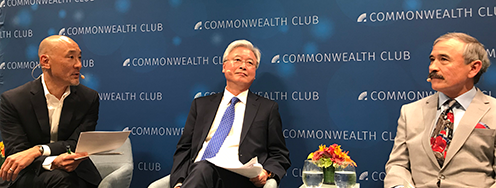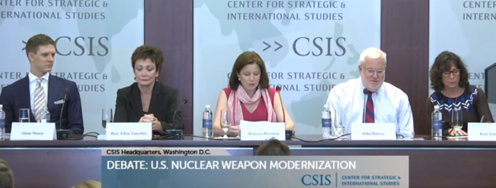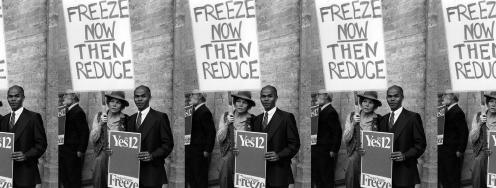McCain Supports Goal of a World Without Nuclear Weapons
Floor Statement by Senator John McCain - A World Without Nuclear Weapons
June 3, 2009
Mr. President, today we celebrate the unveiling in the Capitol of a statue of Ronald Reagan, one of our country’s great presidents and a personal hero to me throughout my political life. While there are many aspects of President Reagan’s legacy we might reflect on today, I’d like to take the opportunity to discuss just one of them: his dream of a world free of nuclear weapons.
Speaking before the Japanese Diet on November 11, 1983, President Ronald Reagan said, “The only value in possessing nuclear weapons is to make sure they can't be used ever. I know I speak for people everywhere when I say our dream is to see the day when nuclear weapons will be banished from the face of the Earth.” That is my dream, too, and it is one shared by many of our most distinguished national security practitioners. In 2007, former Secretaries of State Henry Kissinger and George Shultz, along with former Secretary of Defense William Perry and Senator Sam Nunn, authored an article titled “A World Free of Nuclear Weapons,” in which they laid out their vision of the globe free of the most dangerous weapons ever known.
This is a distant and difficult goal. And we must proceed toward it prudently and pragmatically, and with a focused concern for our security and the security of allies who depend on us. But the Cold War ended almost twenty years ago, and the time has come to take further measures to reduce dramatically the number of nuclear weapons in the world's arsenals. In so doing, the United States can – and indeed, must – show the kind of leadership the world expects from us, in the tradition of American presidents who worked to reduce the nuclear threat to mankind.
Our highest priority must be to reduce the danger that nuclear weapons will ever be used. Such weapons, while still important to deter an attack with weapons of mass destruction against us and our allies, represent the most abhorrent and indiscriminate form of warfare known to man. We do, quite literally, possess the means to destroy all of mankind. We must seek to do all we can to ensure that nuclear weapons will never again be used. As the Administration reviews its nuclear weapons posture, it should, I believe, seek to reduce the size of our nuclear arsenal to the lowest number possible consistent with our security requirements and global commitments. This means a move, as rapidly as possible, to a significantly smaller force. As we take such steps, it will be crucial to continue to deploy a safe and reliable nuclear deterrent, robust missile defenses, and superior conventional forces capable of defending the United States and our allies.
Today we find ourselves at a nuclear crossroads. As rogue nations, including North Korea and Iran, push the nuclear envelope, the perils of a world awash in nuclear weapons is clear. Yet we should also consider the more hopeful alternative – a world in which there are far fewer such weapons than there are today, and in which proliferation, instability, and nuclear terrorism are far less likely. In achieving this world, Ronald Reagan’s dream will be more important than ever before. As Secretaries Kissinger and Shultz wrote with their colleagues in 2008, “Progress must be facilitated by a clear statement of our ultimate goal. Indeed, this is the only way to build the kind of international trust and broad cooperation that will be required to effectively address today's threats. Without the vision of moving toward zero, we will not find the essential cooperation required to stop our downward spiral.”
Make no mistake; we must arrest the downward spiral. North Korea’s recent nuclear test is just the latest provocative demonstration of the troubling reality that the world faces today. Together with Iran’s ongoing commitment to nuclear development, we face real dangers in the proliferation of the world’s most terrible weapons. And so the U.S. must lead the world not only in reducing the size of existing nuclear arsenals, but also in reversing the course of nuclear proliferation. This requires a tough, and tough-minded, approach to both Iran and North Korea, both of whom have gotten away with too much for far too long.
We must also help ensure that other, potential nuclear programs do not get off the ground. Last week, former National Security Advisor Brent Scowcroft joined two colleagues in calling on the President to promote the international ban on the spread of fissile materials that can be used in the production of nuclear weapons. I agree, and urge the President to do so. But we must also strengthen enforcement. We must insist that countries that receive the benefits of peaceful nuclear cooperation return or dismantle what they have received if, at any point, they violate or withdraw from the Non-Proliferation Treaty (NPT). Leading up to the 2010 Non-Proliferation Treaty Review conference, we should lay the groundwork for building an international consensus to ensure that the International Atomic Energy Agency has the tools to be a meaningful agent for achieving the dream of a nuclear weapon free world. And we should work with allies and partners to interdict the spread of nuclear weapons and materials – including any borne on vessels traveling to and from North Korea – under the Proliferation Security Initiative.
As a nation, we have a number of important decisions in the coming months, including those related to a follow-on to the Strategic Arms Reduction Treaty with Russia, the Administration’s planned resubmission of the Comprehensive Test Ban Treaty for ratification, and the need for a robust missile defense shield.
As we move ahead with these and other decisions, let us keep in mind the dream of a nuclear free world enunciated so eloquently by our 40th president. As Secretary Shultz has written, this was a dream that President Reagan pursued with great patience and depth of conviction. We would be wise to follow his lead.



